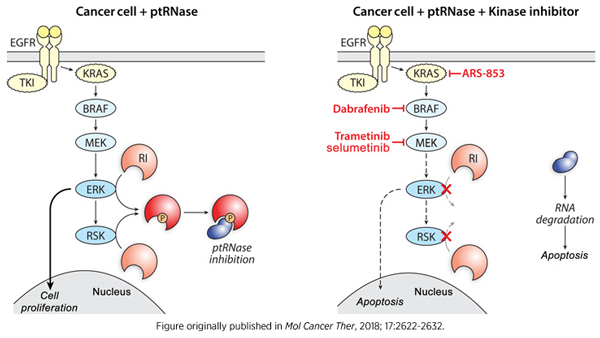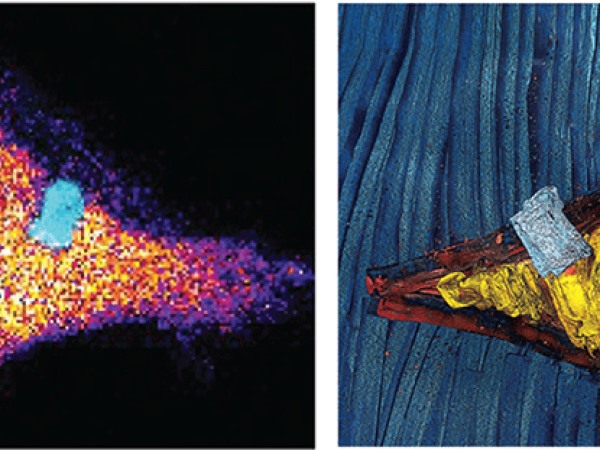December Editors’ Picks from AACR Journals
The staff of Cancer Research Catalyst was pleased to introduce a new feature this year: Editors’ Picks, a monthly collection of articles selected by the editors of the eight scientific journals published by the American Association for Cancer Research (AACR). To wrap up the year, here are the editors’ choices for December. As always, these articles are freely available for a limited time.
Journal: Molecular Cancer Therapeutics
Pancreatic-type ribonucleases (ptRNases), which help to degrade RNA, can be toxic to healthy and cancerous cells, but their activity can be limited by the endogenous protein ribonuclease inhibitor (RI). In this study, the researchers assessed the efficacy of combining the ptRNase QBI-139, which is currently being evaluated in clinical trials for the treatment of solid tumors, with small-molecule kinase inhibitors as a therapeutic strategy in human cancer cells. They found that inhibitors of the ERK pathway in conjunction with QBI-139 exhibited strong synergistic toxicity, as inhibition of ERK kinases suppressed the phosphorylation of RI, which enhances its affinity for ptRNases. These results highlight the efficacy of combinatorial therapies based on underlying mechanisms of action.

The efficacy of ptRNase as a cancer therapeutic can be limited by its interaction with phosphorylated RI. Inhibitors of ERK kinases decrease the phosphorylation of RI, enhancing the activity of ptRNase and allowing for enhanced RNA degradation.
Journal: Cancer Research (December 15 issue)
Most patients with chronic neutrophilic leukemia have mutations in colony stimulating factor 3 receptor (CSF3R), yet the functional significance of many of these mutations remains unclear. In this study, the authors determined that germline mutations to residue N610 in CSF3R were potently oncogenic and resulted in the constitutive activation of the receptor independent of its ligand. Furthermore, analysis via mass spectrometry revealed that this residue lies within a N-linked glycosylation consensus motif, and that point mutations to N610 reduces the glycosylation of CSF3R, a process which enhances oncogenesis. The results presented here identify therapeutically targetable oncogenic mutations in CSF3R for patients with leukemia.
Journal: Cancer Prevention Research
Understanding the biological pathways that contribute to high breast density, one of the strongest risk factors for breast cancer, may identify molecular targets for breast cancer prevention. In this study, the researchers evaluated the associations between mammographic density, measured as volumetric percent density, and circulating levels of receptor activator of nuclear factor-κB (RANK) and soluble RANK ligand (sRANKL) in 365 cancer-free premenopausal women. They found that circulating RANK levels were positively associated with volumetric percent density, and circulating sRANKL levels were positively associated with volumetric percent density only among women with high progesterone levels. The authors conclude that the inhibition of RANKL signaling may help to reduce mammographic breast density and breast cancer incidence in women with dense breasts.
Journal: Clinical Cancer Research (December 1 issue)
While biopsies can be obtained from patients with diffuse midline glioma (DMG) at the time of disease presentation, rebiopsy at the time of disease progression is rare due to risks, costs, and clinical regulations; lack of knowledge about molecular changes and disease response significantly hinders the development of effective therapeutic interventions. In this study, the authors utilized a liquid biopsy-based approach to probe for disease driver mutations in patients with DMG. The authors could successfully detect H3K27M, a mutation to the histone protein H3 which is often observed in DMG, in 90 percent of subjects, and they also found that decreases of H3K27M in plasma correlated with response to radiotherapy in 83 percent of patients as validated by MRI assessment. The researchers state that this is the first study to illustrate the clinical utility of liquid biopsies for the longitudinal surveillance of DMGs.
Journal: Clinical Cancer Research (December 15 issue)
The identification of patients who will derive long-term benefit from treatment with immunotherapy remains a challenge in the field. In this study, the researchers correlated changes in the variant allele frequencies (VAF) in circulating tumor DNA (ctDNA) from patients with non-small cell lung cancer and urothelial cancer treated with the anti-PD-L1 therapy durvalumab with clinical outcomes. The authors determined that alterations in VAF could precede radiographic responses and that patients with a reduction of VAF six weeks following commencement of treatment had significantly greater reduction in tumor volume, longer progression-free survival, and longer overall survival. These results suggest that the early monitoring of ctDNA VAF may help to identify patients who will benefit from durvalumab monotherapy.
Journal: Cancer Immunology Research
Cancer-associated fibroblasts (CAFs), which are often correlated with poor prognosis, display heterogeneity in composition and function, yet how CAFs suppress responses to immunotherapy remains unclear. In this study, the authors could categorize mouse and human breast tumors expressing fibroblast activation protein (FAP), a marker for CAFs, into two discrete populations based on the expression of podoplanin (PDPN): while the FAP+PDPN+ population was composed of CAFs, the FAP+PDPN– population was composed of cancer-associated pericytes (CAPs). The PDPN+ CAF population was enriched at the tumor periphery and suppressed the proliferation of T cells in a nitric oxide-dependent manner, while the CAP population localized around vasculature and were not immunosuppressive. These results illustrate the dichotomous functions, phenotypes, and locations of FAP-expressing stromal cells in breast tumors.
Journal: Cancer Discovery
Mutated isoforms of isocitrate dehydrogenase (IDH1 or IDH2) produce 2-hydroxyglutarate (2HG), which contributes to oncogenesis. The treatment of IDH-mutant malignancies with IDH inhibitors can suppress the production of 2HG, but reasons for resistance to these therapies remain unknown. In this study, the authors identified mutant IDH isoform switching (from mutant IDH1 to mutant IDH2, or vice versa) as a mechanism of acquired resistance to IDH inhibition in four patients, thereby allowing the production of 2HG. The authors conclude that serial DNA sequencing and measurement of 2HG in patients treated with IDH inhibitors may facilitate response monitoring, elucidate resistance mechanisms, and guide treatment recommendations.
Journal: Cancer Epidemiology, Biomarkers & Prevention
African Americans (AAs) have increased lung cancer incidence and worse survival compared to European Americans (EAs); these racial disparities are an active area of investigation. In this study, the researchers evaluated whether the use of the anti-inflammatory drug aspirin was associated with non-small cell lung cancer (NSCLC) risk and survival in AA and EA populations. The researchers found that any aspirin use, daily use of at least one aspirin tablet, and aspirin use of at least three years were all significantly associated with lower NSCLC risk among men in both populations, and that all three of these variables were significantly associated with improved survival among AAs with lung cancer. These results suggest that the regular use of aspirin may be preventive among men overall and improve NSCLC survival in both men and women in the AA population.
Journal: Cancer Research (December 1 issue)
Deficiencies in natural killer (NK) cells can aid the progression of hepatocellular carcinoma (HCC), yet the underlying mechanisms that impair NK cells remain unclear. In this study, the authors evaluated the expression of CD160, a cell surface glycoprotein, on intrahepatic NK cells from peritumoral and intratumoral tissues. The researchers found that patients with lower intratumoral CD160 expression had higher levels of metastasis and recurrence, and that the cytokine TGF-β1 can functionally impair CD160+ NK cells, facilitating tumor immune escape. These results suggest that modulation of CD160 may have therapeutic potential in controlling tumor metastases in patients with HCC.
Journal: Molecular Cancer Research
“Z4” Complex Member Fusions in NUT Carcinoma: Implications for a Novel Oncogenic Mechanism
NUT carcinoma (NC), an aggressive subtype of squamous cell carcinoma, is characterized by the presence of NUT-fusion oncogenes and has no known effective treatment. In this study, the authors identified the zinc finger protein encoding gene ZNF592 as a novel fusion partner to NUT in a patient with NC; ZNF592 has been previously identified as a component of the BRD4-NUT complex, which is oncogenic. The researchers found that “Z4” complex proteins ZNF952, ZNF532, and ZMYND8 co-localize with BRD4-NUT, and that knockdown of ZNF952 and ZNF532 decreased the viability of NC cells. These results identify Z4 complex proteins as oncogenic factors in NC and may guide new targeted therapeutic strategies.



